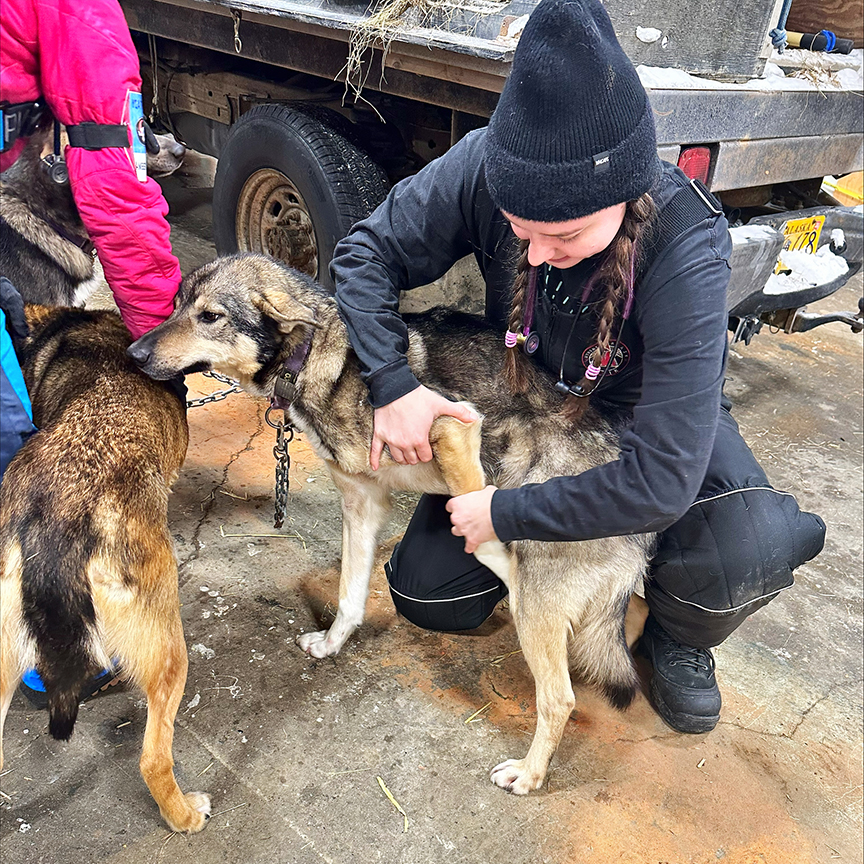Study charts dog injuries’ impact on Yukon Quest finishes
Lea Gardine
907-474-7541
March 1, 2024

UAF veterinary medicine students inspect dogs at the Yukon Quest race start in 2024.
Sled dogs that have wrist injuries during the Yukon Quest International Sled Dog Race are more likely to finish the race than dogs with other types of injury or illness, researchers have discovered.
Jenna Hattendorf, a doctoral student in veterinary medicine at Colorado State University, led the research with the guidance of Dr. Cristina Hansen, chair of the University of Alaska Fairbanks Department of Veterinary Medicine and Yukon Quest head veterinarian.
The study, published in the journal Frontiers in Veterinary Science, reviewed the vet books from the 2018-2020 races. They summarized illnesses and orthopedic injuries diagnosed in both dropped dogs and those that finished. Information from 711 records from dogs in teams that finished the race was used in the analysis, with more than 50 percent noting at least one abnormal finding.
The study’s findings may be used to help race vets and mushers make informed decisions about whether to take a dog out of the team during the race.
“Previous studies have detailed the injuries that resulted in dropping a dog from the race, but thus far, none have looked at the injuries sustained in dogs that went on to finish,” said Hansen. “We wanted to know what the chances of a dog finishing would be in order to make more informed decisions in the future.”
Hansen’s interest in this topic prompted an internship for Hattendorf, who reviewed records to categorize the injuries and illnesses the dogs sustained during the races and to note if they finished.

Jenna Hattendorf examines the front limb of a sled dog during the 2024 Yukon Quest International Sled Dog Race.
The authors discovered the most common racing injuries are orthopedic — involving the skeleton and muscle systems. These injuries are also the most common reason for dropping a dog from competition. However, not all orthopedic injuries are the same.
Carpal, or wrist, injuries were most common, followed by shoulder injuries. The research shows that dogs have a good chance of recovering and continuing a race if they experience a carpal injury and treatment is administered promptly.
“More than half, 54.6 percent, of dogs that injured their wrist went on to finish the race, but only 9.4 percent of dogs with shoulder injuries finished,” Hattendorf said. “I would have assumed that all orthopedic injuries have the same risk of dropping a dog from the race, but the difference came as a surprise.”
The authors also determined that the odds of dogs being dropped during different stages in the race varies by race direction — either Fairbanks to Whitehorse or vice versa. During Fairbanks-start years, more dogs are dropped during the first quarter of the race. During Whitehorse-start years, more dogs are dropped during the second quarter.
The authors hope to continue this research by including more race years and information about weather and trail conditions, as well as seeing how it compares to other ultra-endurance sled dog races.
ADDITIONAL CONTACT: Cristina Hansen, cmhansen@alaska.edu, 907-474-1504; Jenna Hattendorf, jenna.hattendorf@colostate.edu
NOTE FOR EDITORS: Additional photos available by request.
151-24


